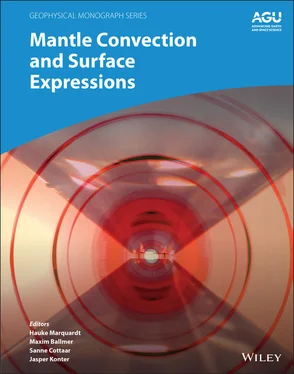The authors thank John Hernlund and Fred Richards for their reviews, which improved the quality and clarity of the manuscript. The authors thank Ebru Bozdağ for providing the GLAD‐M15 tomographic model and for helpful discussions about this model. All of the authors acknowledge support from the National Science Foundation through NSF Geophysics grant EAR‐1825104, and MLR acknowledges NSF CSEDI grant EAR‐1800450. Computational resources were provided through NSF Major Research Instrumentation grant DMS‐1624776 to Portland State University and by UC Davis. VL acknowledges support from the Packard Foundation.
1 Austermann, J., B. T. Kaye, J. X. Mitrovica, & P. Huybers (2014). A statistical analysis of the correlation between large igneous provinces and lower mantle seismic structure. Geophysical Journal International, 197(1), 1–9, doi:10.1093/gji/ggt500.
2 Ballmer, M. D., N. C. Schmerr, T. Nakagawa, & J. Ritsema (2015). Compositional mantle layering revealed by slab stagnation at ∼1000‐km depth. Science Advances, 1(11), e1500,815, doi:10.1126/sciadv.1500815.
3 Becker, T. W., & L. Boschi (2002). A comparison of tomographic and geodynamic mantle models. Geochemistry, Geophysics, Geosystems, 3(1), 1003–n/a, doi:10.1029/2001GC000168.
4 Becker, T. W., C. O’Neill, & B. Steinberger (2014). HC, a global mantle circulation solver.
5 Boioli, F., P. Carrez, P. Cordier, B. Devincre, K. Gouriet, P. Hirel, A. Kraych, & S. Ritterbex (2017). Pure climb creep mechanism drives flow in Earth’s lower mantle. Science Advances, 3(3), e1601,958, doi:10.1126/sciadv.1601958.
6 Boschi, L., & A. M. Dziewonski (1999). High‐ and low‐resolution images of the Earth’s mantle: Implications of different approaches to tomographic modeling. Journal of Geophysical Research: Solid Earth, 104(B11), 25,567–25,594, doi:10.1029/1999JB900166.
7 Bower, D. J., M. Gurnis, & M. Seton (2013). Lower mantle structure from paleogeographically constrained dynamic Earth models. Geochemistry, Geophysics, Geosystems, 14(1), 44–63, doi:10.1029/2012GC004267.
8 Bozdağ, E., D. Peter, M. Lefebvre, D. Komatitsch, J. Tromp, J. Hill, N. Podhorszki, & D. Pugmire (2016). Global adjoint tomography: first‐generation model. Geophysical Journal International, 207(3), 1739–1766, doi:10.1093/gji/ggw356.
9 Burke, K., & T. H. Torsvik (2004). Derivation of Large Igneous Provinces of the past 200 million years from long‐term heterogeneities in the deep mantle. Earth and Planetary Science Letters, 227(3–4), 531–538.
10 Burke, K., B. Steinberger, T. H. Torsvik, & M. A. Smethurst (2008). Plume Generation Zones at the margins of Large Low Shear Velocity Provinces on the core–mantle boundary. Earth and Planetary Science Letters, 265(1–2), 49–60, doi:10.1016/j.epsl.2007.09.042.
11 Cammarano, F., S. Goes, P. Vacher, & D. Giardini (2003). Inferring upper‐mantle temperatures from seismic velocities. Physics of the Earth and Planetary Interiors, 138(3), 197–222, doi:10.1016/S0031‐9201(03)00156‐0.
12 Capdeville, Y., Y. Gung, & B. Romanowicz (2005). Towards global earth tomography using the spectral element method: a technique based on source stacking. Geophysical Journal International, 162(2), 541–554, doi:10.1111/j.1365‐246X.2005.02689.x.
13 Chambat, F., Y. Ricard, & B. Valette (2010). Flattening of the Earth: further from hydrostaticity than previously estimated. Geophysical Journal International, 183(2), 727–732, doi:10.1111/j.1365‐246X.2010.04771.x.
14 Christensen, U. R., & D. A. Yuen (1985). Layered convection induced by phase transitions. Journal of Geophysical Research: Solid Earth, 90(B12), 10,291–10,300, doi:10.1029/JB090iB12p10291.
15 Conrad, C. P., B. Steinberger, & T. H. Torsvik (2013). Stability of active mantle upwelling revealed by net characteristics of plate tectonics. Nature, 498(7455), 479–482, doi:10.1038/nature12203.
16 Cottaar, S., & V. Lekic (2016). Morphology of seismically slow lower‐mantle structures. Geophysical Journal International, 207(2), 1122–1136, doi:10.1093/gji/ggw324.
17 Dahlen, F. A., & J. Tromp (1998). Theoretical Global Seismology, Princeton University Press.
18 Davaille, A., F. Girard, & M. Le Bars (2002), How to anchor hotspots in a convecting mantle? Earth and Planetary Science Letters, 203(2). 621–634, doi:10.1016/S0012‐821X(02)00897‐X.
19 Davies, D. R., S. Goes, & H. C. P. Lau (2015), Thermally Dominated Deep Mantle LLSVPs: A Review. In A. Khan and F. Deschamps (Eds.), The Earth’s Heterogeneous Mantle: A Geophysical, Geodynamical, and Geochemical Perspective, pp. 441–477, Springer International Publishing, Cham, doi:10.1007/978‐3‐319‐15627‐9_14.
20 Deng, J., & K. K. M. Lee (2017). Viscosity jump in the lower mantle inferred from melting curves of ferropericlase. Nature Communications, 8(1), 1997, doi:10.1038/s41467‐017‐02263‐z.
21 Domeier, M., P. V. Doubrovine, T. H. Torsvik, W. Spakman, & A. L. Bull (2016). Global correlation of lower mantle structure and past subduction. Geophysical Research Letters, 43(10), 4945–4953, doi:10.1002/2016GL068827.
22 Durand, S., E. Debayle, Y. Ricard, C. Zaroli, & S. Lambotte (2017). Confirmation of a change in the global shear velocity pattern at around 1000 km depth. Geophysical Journal International, 211(3), 1628–1639, doi:10.1093/gji/ggx405.
23 Fei, Y., J. Van Orman, J. Li, W. van Westrenen, C. Sanloup, W. Minarik, K. Hirose, T. Komabayashi, M. Walter, & K. Funakoshi (2004). Experimentally determined postspinel transformation boundary in Mg2SiO4 using MgO as an internal pressure standard and its geophysical implications. Journal of Geophysical Research: Solid Earth (1978–2012), 109(B2).
24 Forte, A. M., & J. X. Mitrovica (2001). Deep‐mantle high‐viscosity flow and thermochemical structure inferred from seismic and geodynamic data. Nature, 410, 1049–1056.
25 Forte, A. M., A. M. Dziewonski, & R. L. Woodward (1993), Aspherical Structure of the Mantle, Tectonic Plate Motions, Nonhydrostatic Geoid, and Topography of the Core‐Mantle Boundary. In Dynamics of Earth’s Deep Interior and Earth Rotation, pp. 135–166, American Geophysical Union (AGU). doi:10.1029/GM072p0135.
26 French, S. W., & B. Romanowicz (2015), Broad plumes rooted at the base of the Earth’s mantle beneath major hotspots. Nature, 525(7567). 95–99, doi:10.1038/nature14876.
27 French, S. W., & B. A. Romanowicz (2014), Whole‐mantle radially anisotropic shear velocity structure from spectral‐element waveform tomography. Geophysical Journal International, 199(3). 1303–1327, doi:10.1093/gji/ggu334.
28 Frost, D. A., E. J. Garnero, & S. Rost (2018), Dynamical links between small‐ and large‐scale mantle heterogeneity: Seismological evidence. Earth and Planetary Science Letters, 482, 135–146, doi:10.1016/j.epsl.2017.10.058.
29 Fukao, Y., & M. Obayashi (2013). Subducted slabs stagnant above, penetrating through, and trapped below the 660 km discontinuity. Journal of Geophysical Research (Solid Earth), 118(11), 2013JB010,466–5938, doi:10.1002/2013JB010466.
30 Ghosh, A., T. W. Becker, & S. J. Zhong (2010). Effects of lateral viscosity variations on the geoid. Geophysical Research Letters, 37(1), 01,301, doi:10.1029/2009GL040426.
31 Girard, J., G. Amulele, R. Farla, A. Mohiuddin, and S.‐i. Karato (2016). Shear deformation of bridgmanite and magnesiowüstite aggregates at lower mantle conditions. Science, 351(6269), 144–147, doi:10.1126/science.aad3113.
32 Green, P. J. (1995). Reversible jump Markov chain Monte Carlo computation and Bayesian model determination. Biometrika, 82(4), 711–732, doi:10.1093/biomet/82.4.711.
33 Hager, B. H., & R. J. O’Connell (1981). A simple global model of plate dynamics and mantle convection. Journal of Geophysical Research, 86(B), 4843–4867, doi:10.1029/JB086iB06p04843.
Читать дальше












